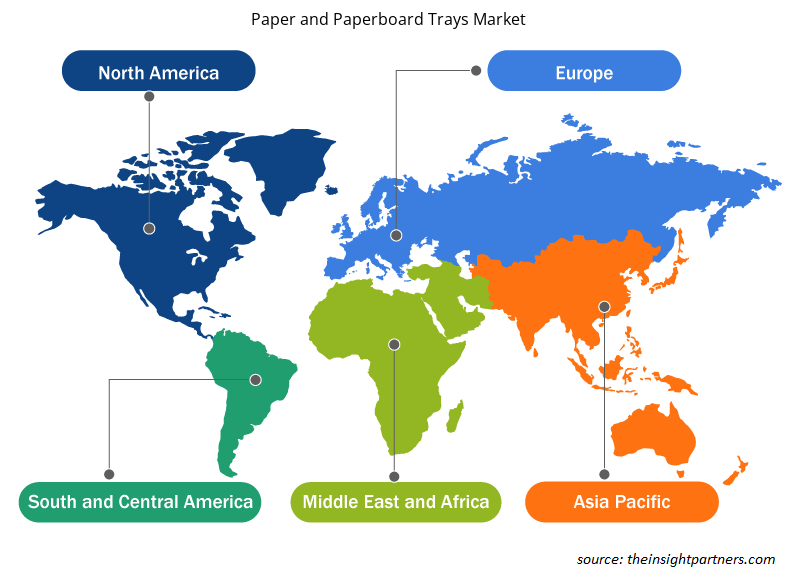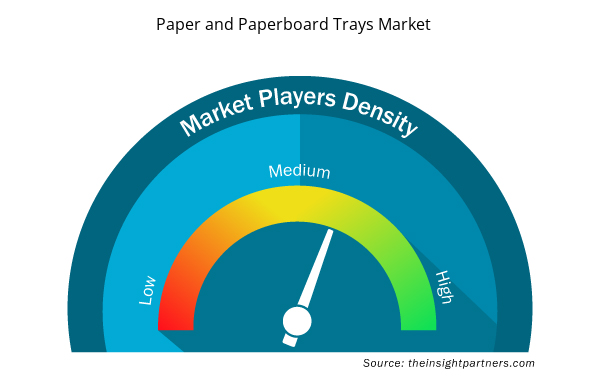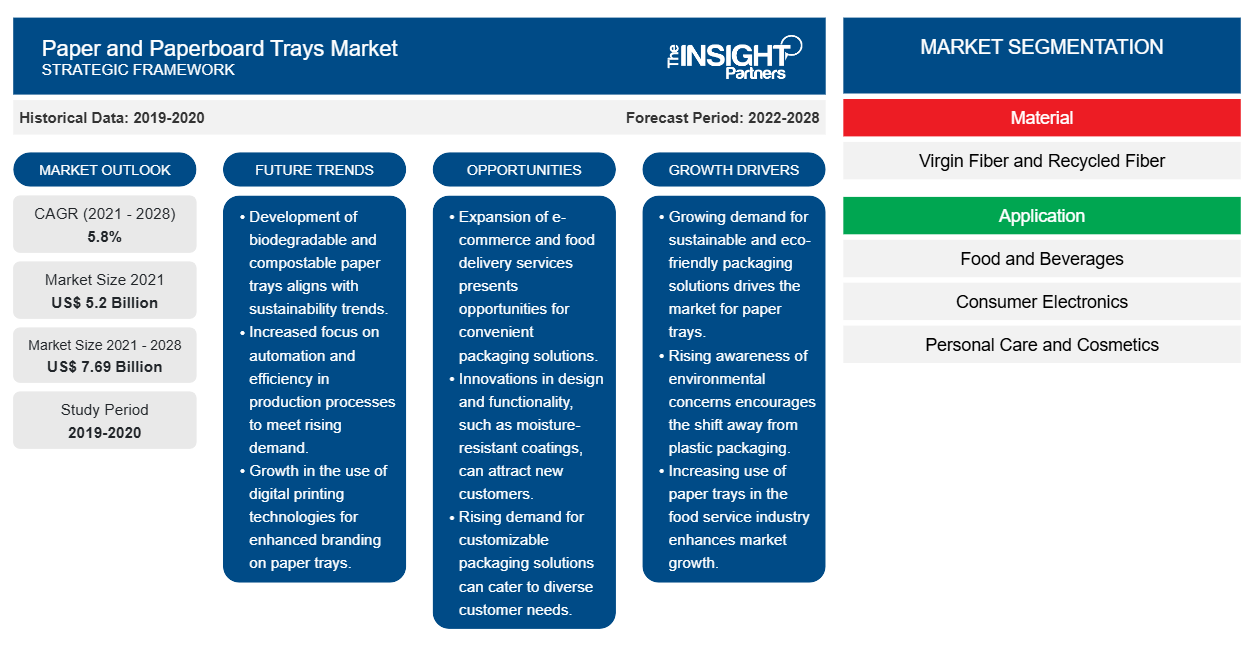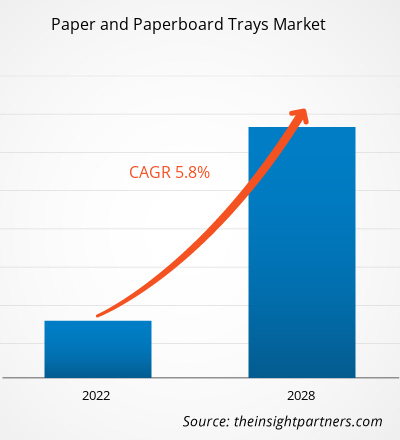预计到 2028 年,纸和纸板托盘市场规模将从 2021 年的 51.9524 亿美元增至 76.9418 亿美元;预计 2021 年至 2028 年的复合年增长率为 5.8%。
纸和纸板托盘是通常用于包装新鲜水果和蔬菜、鸡蛋、沙拉、干果和其他食品和饮料产品的包装产品。这些托盘还用于包装消费电子产品,如手机、笔记本电脑、耳机、打印机、化妆品和个人护理产品、医疗保健工具和设备,以及消费品,如玻璃器皿和珠宝。这些托盘由原生或再生纤维制成。它们为包装内的产品提供缓冲,以确保其在运输过程中的安全。
2020 年,亚太地区占据全球纸和纸板托盘市场的最大收入份额。由于包装行业的快速发展、食品零售和餐饮服务业的增长以及整个地区消费者对可持续包装解决方案的认识不断提高,亚太地区的纸和纸板包装市场见证了显着增长。由于旅游业的增长和消费者生活方式的改善以及可支配收入水平的提高,亚太地区的餐饮服务业正在扩大。纸和纸板托盘制造商主要专注于在亚太地区扩展业务,因为该地区拥有庞大的客户群、廉价的基础设施和劳动力设施、丰富的资源以及自由贸易政策。预计这一因素将在未来几年为制造商带来丰厚的机会。
定制此报告以满足您的需求
您可以免费定制任何报告,包括本报告的部分内容、国家级分析、Excel 数据包,以及为初创企业和大学提供优惠和折扣
- 获取此报告的关键市场趋势。这个免费样品将包括数据分析,从市场趋势到估计和预测。
COVID-19 疫情对纸和纸板托盘市场的影响
由于封锁、旅行禁令和企业停工,COVID-19 疫情影响了各国的经济和行业。北美、欧洲、亚太、南美、中东和非洲等地区的多家制造工厂关闭,影响了全球供应链,并对各种商品的生产能力、交货时间表和销售产生了负面影响。疫情直接影响了生产和需求,导致供应链和市场中断,进而影响了企业的财务状况和全球经济。包装是遭受严重破坏的主要行业之一,例如供应链中断和生产工厂停工。
随着 COVID 19 在全球蔓延,大多数国家宣布进入卫生紧急状态并停止不必要的流动,从而严重影响了商品供应链。供应链中断导致生产放缓。制造工厂因社交距离而匆忙做出改变,导致更多的中断和生产放缓。纸和纸板行业的供应链可能会继续出现薄弱或断裂的环节。此外,自我隔离导致供应短缺,大量制造单位正在从中国以外的地方采购供应链。
市场洞察
可持续产品需求不断增长推动纸和纸板托盘市场发展
全球多个行业(尤其是食品和饮料行业)对可持续和灵活包装应用的需求不断增长,这是推动全球纸和纸板托盘市场发展的关键因素。食品和饮料对经济高效的纸板包装的需求不断增长也是刺激纸和纸板托盘需求的另一个重要因素。由于日益增长的环境问题,政府和其他监管机构正在强调使用可回收产品。此外,他们还制定了有关可持续产品使用的严格规定,这是推动纸和纸板托盘市场增长的主要因素之一。
材料洞察
根据材料,全球纸和纸板托盘市场分为原生纤维和再生纤维。2020 年,原生纤维部分在全球纸和纸板托盘市场中占有较大份额。原生纤维是从新鲜木材的纸浆中获得的。用原生纤维制成的纸不含再生材料。原生纤维广泛用于包装行业,用于制造纸和纸板产品。用于包装水果、鸡蛋和蔬菜等食品的纸板托盘是使用原生纤维制成的,因为它们可以防止污染、异味和迁移问题,从而确保食品安全,并符合食品安全法规。原生纤维强度高,不易断裂。
应用程序洞察
根据应用,全球纸和纸板托盘市场分为食品和饮料、消费电子产品、个人护理和化妆品、医疗保健等。2020 年,食品和饮料部门占据了全球纸和纸板托盘市场的最大份额。纸和纸板托盘已广泛用于包装鸡蛋、新鲜水果和蔬菜以及沙拉等食品。这些托盘为这些产品的脆弱表面提供缓冲,以确保运输过程中的安全。纸和纸板托盘确保包装内部适当通风,以保持食品新鲜。此外,这些托盘通过保护食品免受污染和异味来确保食品安全。它们还符合食品安全法规,使其成为整个食品和饮料行业最受欢迎的包装替代品之一。
Huhtamaki;Mondi;Pactiv Evergreen Inc.;UFP Technologies, Inc.;Hartmann;Orcon Industries;International Paper;Athena Superpack Private Limited;PaperTech;和 SOLUT! 是全球纸和纸板托盘市场的主要市场参与者。市场参与者高度专注于开发高质量和创新的产品以满足客户的需求。
报告亮点
- 纸和纸板托盘市场的渐进式行业趋势可帮助参与者制定有效的长期战略
- 发达市场和发展中市场采用的业务增长战略
- 2019 年至 2028 年纸和纸板托盘市场的定量分析
- 全球纸和纸板托盘需求量估计
- 波特五力分析说明了行业内买家和供应商的效力
- 了解竞争市场状况的最新发展
- 市场趋势和前景以及推动和抑制纸和纸板托盘市场增长的因素
- 通过强调支撑商业利益的市场策略来协助决策过程,从而促进市场增长
- 不同节点的纸和纸板托盘市场规模
- 市场的详细概述和细分,以及纸和纸板托盘行业动态
- 各地区纸和纸板托盘市场规模及增长机遇
纸和纸板托盘市场区域洞察
Insight Partners 的分析师已详尽解释了预测期内影响纸和纸板托盘市场的区域趋势和因素。本节还讨论了北美、欧洲、亚太地区、中东和非洲以及南美和中美洲的纸和纸板托盘市场细分和地理位置。

- 获取纸和纸板托盘市场的区域特定数据
纸和纸板托盘市场报告范围
| 报告属性 | 细节 |
|---|---|
| 2021 年市场规模 | 52亿美元 |
| 2028 年市场规模 | 76.9 亿美元 |
| 全球复合年增长率(2021 - 2028) | 5.8% |
| 史料 | 2019-2020 |
| 预测期 | 2022-2028 |
| 涵盖的领域 | 按材质
|
| 覆盖地区和国家 | 北美
|
| 市场领导者和主要公司简介 |
|
纸和纸板托盘市场参与者密度:了解其对业务动态的影响
纸和纸板托盘市场正在快速增长,这得益于最终用户需求的不断增长,这些需求源于消费者偏好的不断变化、技术进步以及对产品优势的认识不断提高等因素。随着需求的增加,企业正在扩大其产品范围,进行创新以满足消费者的需求,并利用新兴趋势,从而进一步推动市场增长。
市场参与者密度是指在特定市场或行业内运营的企业或公司的分布情况。它表明在给定市场空间中,相对于其规模或总市场价值,有多少竞争对手(市场参与者)存在。
在纸和纸板托盘市场运营的主要公司有:
- 胡赫塔迈基
- 蒙迪
- Pactiv 长青公司
- UFP 技术公司
- 哈特曼
免责声明:上面列出的公司没有按照任何特定顺序排列。

- 获取纸和纸板托盘市场顶级关键参与者概述
全球纸和纸板托盘市场
按材质
- 原生纤维
- 再生纤维
按应用
- 食品和饮料
- 消费电子产品
- 个人护理和化妆品
- 卫生保健
- 其他的
公司简介
- 胡赫塔迈基
- 蒙迪
- Pactiv 长青公司
- UFP 技术公司
- 哈特曼
- 奥康工业公司
- 国际纸业
- 雅典娜超级包装私人有限公司
- 造纸技术
- 解決!
- 历史分析(2 年)、基准年、预测(7 年)及复合年增长率
- PEST 和 SWOT 分析
- 市场规模价值/数量 - 全球、区域、国家
- 行业和竞争格局
- Excel 数据集


- Architecture Software Market
- Hydrolyzed Collagen Market
- Semiconductor Metrology and Inspection Market
- Ceiling Fans Market
- Drain Cleaning Equipment Market
- 3D Mapping and Modelling Market
- Intradermal Injection Market
- Military Rubber Tracks Market
- Adaptive Traffic Control System Market
- HVAC Sensors Market

Report Coverage
Revenue forecast, Company Analysis, Industry landscape, Growth factors, and Trends

Segment Covered
This text is related
to segments covered.

Regional Scope
North America, Europe, Asia Pacific, Middle East & Africa, South & Central America

Country Scope
This text is related
to country scope.
常见问题
The demand for paper and paperboard trays for consumer electronics have been witnessing significant growth over the years. It is expected to be one of the fastest growing application segments of the global paper and paperboard trays market. These products are delicate and are susceptible to damage caused by heavy impacts during transportation. Paper and paperboard trays ensure safety of the electronic gadgets and prevent damages caused by heavy impacts and mishandling of the goods in transit.
Rapidly growing packaging industry, food retail and foodservice sector, and rising consumer awareness about sustainable packaging solutions across the region have significantly contributed to the growth of the paper and paperboard trays market in Asia Pacific. Improving lifestyles and tourism sector in the region has also aided the growth of the retail food sector in the region. Such factors have propelled the demand for paperboard trays in Asia Pacific.
Paper and paperboard trays have been widely used for packaging food products such as eggs, fresh fruits and vegetables, and salad, among others. These trays provide a cushioning effect to the delicate surface of these products and ensure their safety during transportation. Paper and paperboard trays ensure proper ventilation inside the package which keeps the food products fresh.
Virgin fiber accounted for the largest share of the paper and paperboard trays market. Paper can only be recycled up to 5-6 times. Hence, a steady supply of virgin fiber is necessary to meet the growing demand for paper based packaging. However, recycling benefits and incentives provided by the regulatory authorities have increased the penetration of recycled fiber in the paper and paperboard trays market.
The major players operating in the global paperboard trays market are Huhtamaki, Mondi, UFP Technologies, Pactiv LLC, Hartmann, Orcon Industries Corporation, International Paper, Arthena Superpack Private Limited, Papertech, and Solut among many others.
Paper and paperboard trays are used in a wide array of industries ranging from food and beverages, consumer goods, healthcare and many others. They play a vital role in sustainable packaging and with the growing interest in shifting away from single-use plastic, paper based packaging solutions have been witnessing significant demand.
Based, on material, the paperboard trays market is virgin fiber and recycled fiber. Based on application, the global paperboard trays market is segmented into food and beverages, consumer electronics, personal care and cosmetics, healthcare, and others.
Trends and growth analysis reports related to Chemicals and Materials : READ MORE..
The List of Companies - Paper and Paperboard Trays Market
- Huhtamaki
- Mondi
- Pactiv Evergreen Inc.
- UFP Technologies, Inc.
- Hartmann
- Orcon Industries
- International Paper
- Athena Superpack Private Limited
- PaperTech
- SOLUT!
The Insight Partners performs research in 4 major stages: Data Collection & Secondary Research, Primary Research, Data Analysis and Data Triangulation & Final Review.
- Data Collection and Secondary Research:
As a market research and consulting firm operating from a decade, we have published and advised several client across the globe. First step for any study will start with an assessment of currently available data and insights from existing reports. Further, historical and current market information is collected from Investor Presentations, Annual Reports, SEC Filings, etc., and other information related to company’s performance and market positioning are gathered from Paid Databases (Factiva, Hoovers, and Reuters) and various other publications available in public domain.
Several associations trade associates, technical forums, institutes, societies and organization are accessed to gain technical as well as market related insights through their publications such as research papers, blogs and press releases related to the studies are referred to get cues about the market. Further, white papers, journals, magazines, and other news articles published in last 3 years are scrutinized and analyzed to understand the current market trends.
- Primary Research:
The primarily interview analysis comprise of data obtained from industry participants interview and answers to survey questions gathered by in-house primary team.
For primary research, interviews are conducted with industry experts/CEOs/Marketing Managers/VPs/Subject Matter Experts from both demand and supply side to get a 360-degree view of the market. The primary team conducts several interviews based on the complexity of the markets to understand the various market trends and dynamics which makes research more credible and precise.
A typical research interview fulfils the following functions:
- Provides first-hand information on the market size, market trends, growth trends, competitive landscape, and outlook
- Validates and strengthens in-house secondary research findings
- Develops the analysis team’s expertise and market understanding
Primary research involves email interactions and telephone interviews for each market, category, segment, and sub-segment across geographies. The participants who typically take part in such a process include, but are not limited to:
- Industry participants: VPs, business development managers, market intelligence managers and national sales managers
- Outside experts: Valuation experts, research analysts and key opinion leaders specializing in the electronics and semiconductor industry.
Below is the breakup of our primary respondents by company, designation, and region:

Once we receive the confirmation from primary research sources or primary respondents, we finalize the base year market estimation and forecast the data as per the macroeconomic and microeconomic factors assessed during data collection.
- Data Analysis:
Once data is validated through both secondary as well as primary respondents, we finalize the market estimations by hypothesis formulation and factor analysis at regional and country level.
- Macro-Economic Factor Analysis:
We analyse macroeconomic indicators such the gross domestic product (GDP), increase in the demand for goods and services across industries, technological advancement, regional economic growth, governmental policies, the influence of COVID-19, PEST analysis, and other aspects. This analysis aids in setting benchmarks for various nations/regions and approximating market splits. Additionally, the general trend of the aforementioned components aid in determining the market's development possibilities.
- Country Level Data:
Various factors that are especially aligned to the country are taken into account to determine the market size for a certain area and country, including the presence of vendors, such as headquarters and offices, the country's GDP, demand patterns, and industry growth. To comprehend the market dynamics for the nation, a number of growth variables, inhibitors, application areas, and current market trends are researched. The aforementioned elements aid in determining the country's overall market's growth potential.
- Company Profile:
The “Table of Contents” is formulated by listing and analyzing more than 25 - 30 companies operating in the market ecosystem across geographies. However, we profile only 10 companies as a standard practice in our syndicate reports. These 10 companies comprise leading, emerging, and regional players. Nonetheless, our analysis is not restricted to the 10 listed companies, we also analyze other companies present in the market to develop a holistic view and understand the prevailing trends. The “Company Profiles” section in the report covers key facts, business description, products & services, financial information, SWOT analysis, and key developments. The financial information presented is extracted from the annual reports and official documents of the publicly listed companies. Upon collecting the information for the sections of respective companies, we verify them via various primary sources and then compile the data in respective company profiles. The company level information helps us in deriving the base number as well as in forecasting the market size.
- Developing Base Number:
Aggregation of sales statistics (2020-2022) and macro-economic factor, and other secondary and primary research insights are utilized to arrive at base number and related market shares for 2022. The data gaps are identified in this step and relevant market data is analyzed, collected from paid primary interviews or databases. On finalizing the base year market size, forecasts are developed on the basis of macro-economic, industry and market growth factors and company level analysis.
- Data Triangulation and Final Review:
The market findings and base year market size calculations are validated from supply as well as demand side. Demand side validations are based on macro-economic factor analysis and benchmarks for respective regions and countries. In case of supply side validations, revenues of major companies are estimated (in case not available) based on industry benchmark, approximate number of employees, product portfolio, and primary interviews revenues are gathered. Further revenue from target product/service segment is assessed to avoid overshooting of market statistics. In case of heavy deviations between supply and demand side values, all thes steps are repeated to achieve synchronization.
We follow an iterative model, wherein we share our research findings with Subject Matter Experts (SME’s) and Key Opinion Leaders (KOLs) until consensus view of the market is not formulated – this model negates any drastic deviation in the opinions of experts. Only validated and universally acceptable research findings are quoted in our reports.
We have important check points that we use to validate our research findings – which we call – data triangulation, where we validate the information, we generate from secondary sources with primary interviews and then we re-validate with our internal data bases and Subject matter experts. This comprehensive model enables us to deliver high quality, reliable data in shortest possible time.


 获取此报告的免费样本
获取此报告的免费样本